Summary
READ ITOpenAI’s Instant Checkout is changing online shopping: customers can buy products directly from ChatGPT results. That shift creates a new battleground for visibility — generative engine optimization (GEO). GEO borrows from SEO but is tuned for AI models that answer questions, continue conversations, and pick merchants based on structured signals. This article explains GEO, how it differs from traditional SEO, and a practical, staged plan you can start implementing within three months.
Why Instant Checkout Matters
When a user asks ChatGPT “what are the best women's hiking boots,” the results can include a buy button next to products whose merchants support instant checkout. Right now many products still show a visit button that links to the merchant site, but Instant Checkout moves the purchase flow inside the chat experience. Over time, personalized assistants that already know user preferences will reduce the role of the shopper in selecting products — and AI will increasingly decide who gets shown.
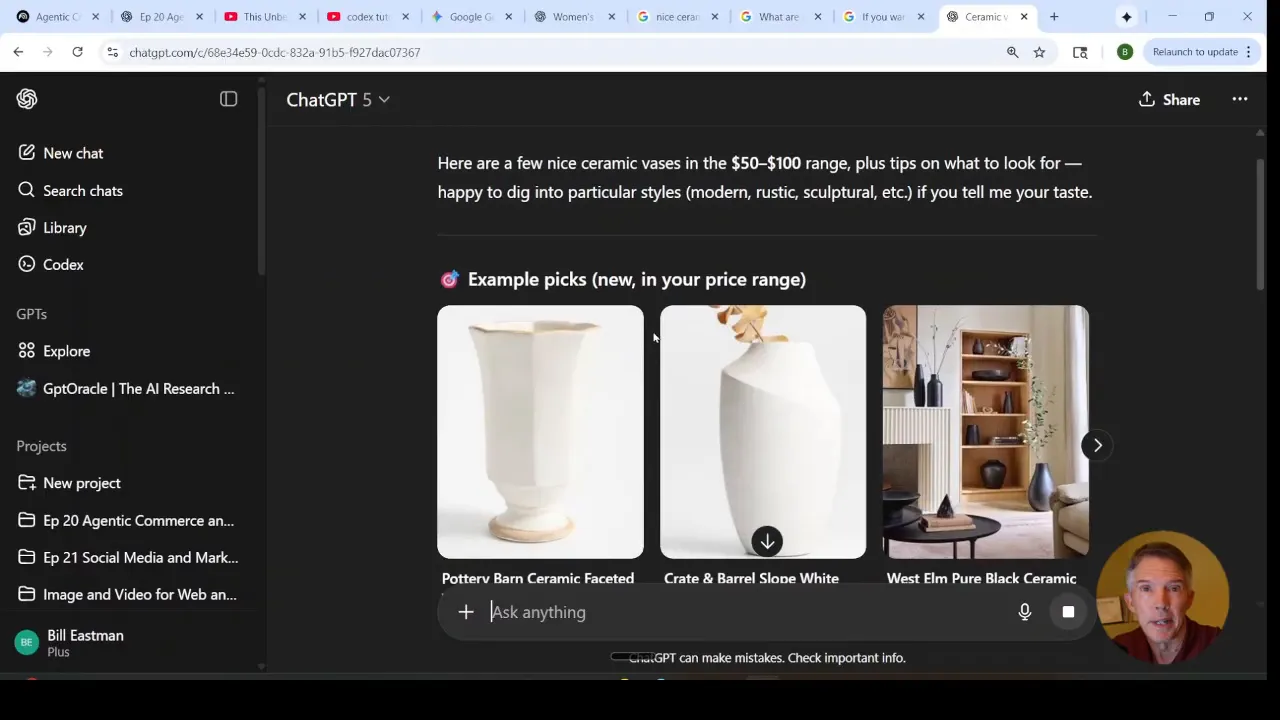
What is Generative Engine Optimization (GEO)?
GEO is the practice of optimizing your web presence so AI models (like ChatGPT) choose your business or products as the answer to user queries. Think of GEO as the next evolution of SEO with three key differences:
- Goal shift: SEO aims to rank pages high in a list; GEO aims to be the direct answer an AI returns.
- Clear, quotable language: AI models favor concise, well-phrased facts over fluffy marketing copy.
- Different authority signals: backlinks remain useful, but GEO values citations from trusted directories, strong customer reviews, and authentic user conversations.
- Platform integration: For product queries, integration with checkout platforms (Stripe, Shopify, Etsy, etc.) becomes essential to enable instant checkout eligibility.
Types of Queries: Discovery vs Transaction
To succeed you must understand two query types:
- Discovery queries — “What’s the best donut shop in Decatur, Georgia?” These should lead to references of your business (listings, reviews, local citations).
- Transaction queries — “Show ceramic vases $50–$100.” These return specific products and require clean product data plus checkout integrations.
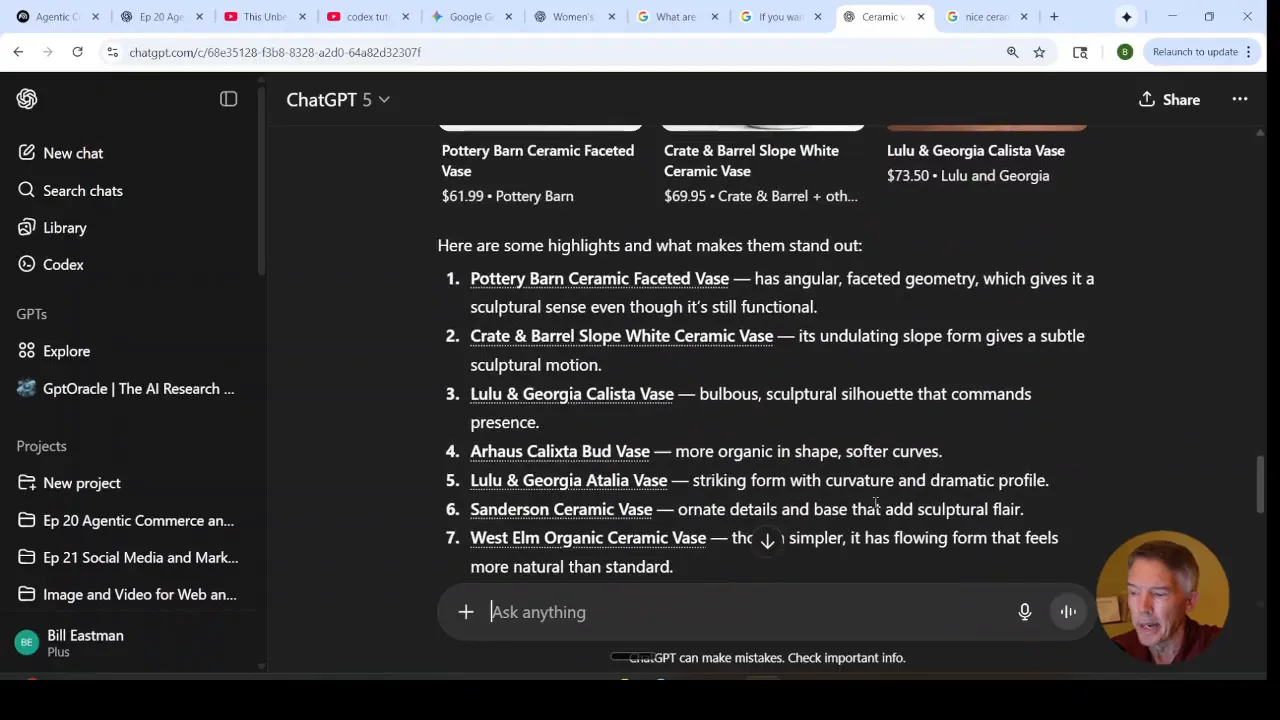
Discovery GEO Guidelines (How to be the obvious local/brand answer)
1. Authority signals
Make sure you appear consistently across business directories (Google Business Profile, Yelp, Bing Places). Build recent, genuine reviews and secure mentions in local media, chamber of commerce directories, and high-quality forum threads (LinkedIn, Reddit).
2. Content discoverability
Rewrite your About, FAQ, menus, and service pages in concise, Q&A style. Avoid marketing fluff — make facts easy to quote. Use short, complete sentences that a language model can pull verbatim.
3. Contextual relevance
Include address, hours, specialties and relevant descriptions in the exact language customers use. Add schema for location, hours, and services so crawlers and models can ingest the data.
4. Trustworthiness
Display ratings, named testimonials, accreditations and awards. When a user asks “what’s the best,” you want the model to find evidence that your business meets that claim.
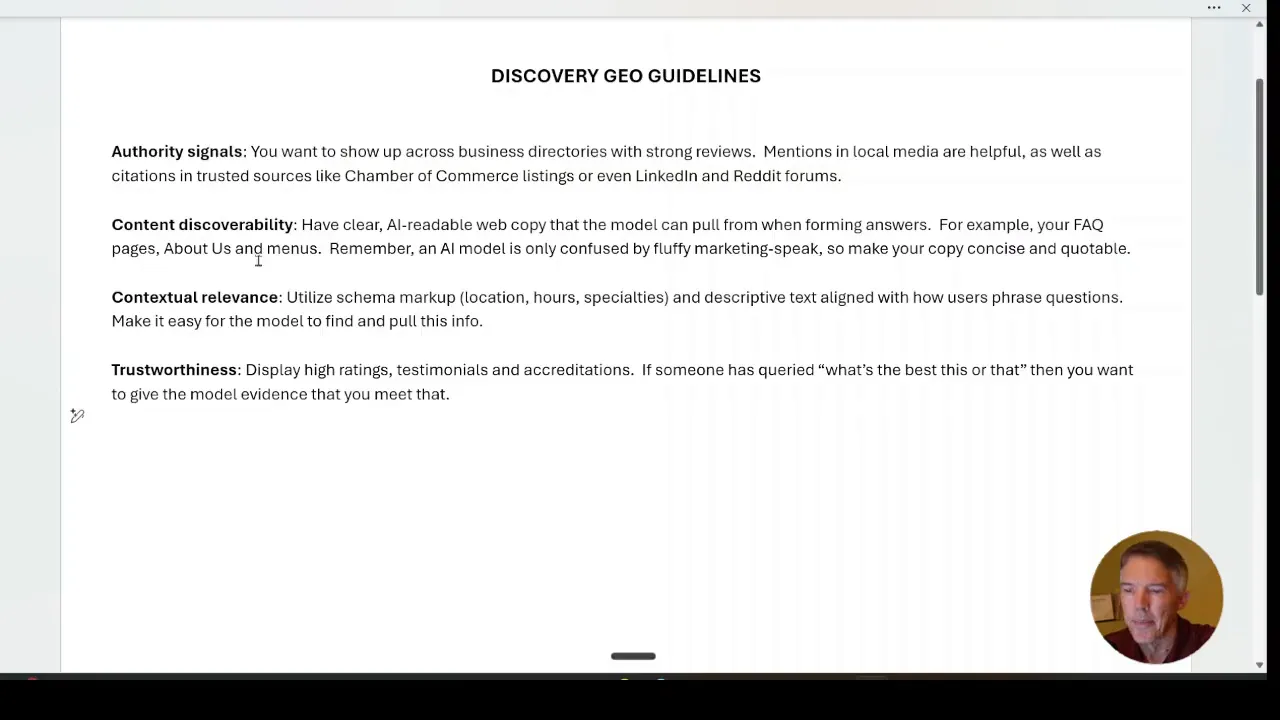
Purchase GEO Guidelines (How to get your products shown and bought)
- Platform integrations: Sync inventory with Stripe, Shopify, Etsy, OpenTable and similar platforms so ChatGPT can access live product data and support instant checkout.
- Structured product data: Use clean product titles, clear SKUs, accurate pricing and availability. Make every field complete and consistent.
- Natural-language product text: Write titles and descriptions the way customers ask questions (e.g., “waterproof women’s hiking boots, size 8, breathable”).
- Frictionless checkout: Merchants without explicit integrations may never be eligible for instant checkout — integration is non-negotiable for product discovery in chat-driven shopping.
- Speed & convenience signals: Highlight same-day pickup, delivery windows, instant digital fulfillment and clear return/cancellation policies. Chat will favor merchants that make the purchase experience fast and low-friction.
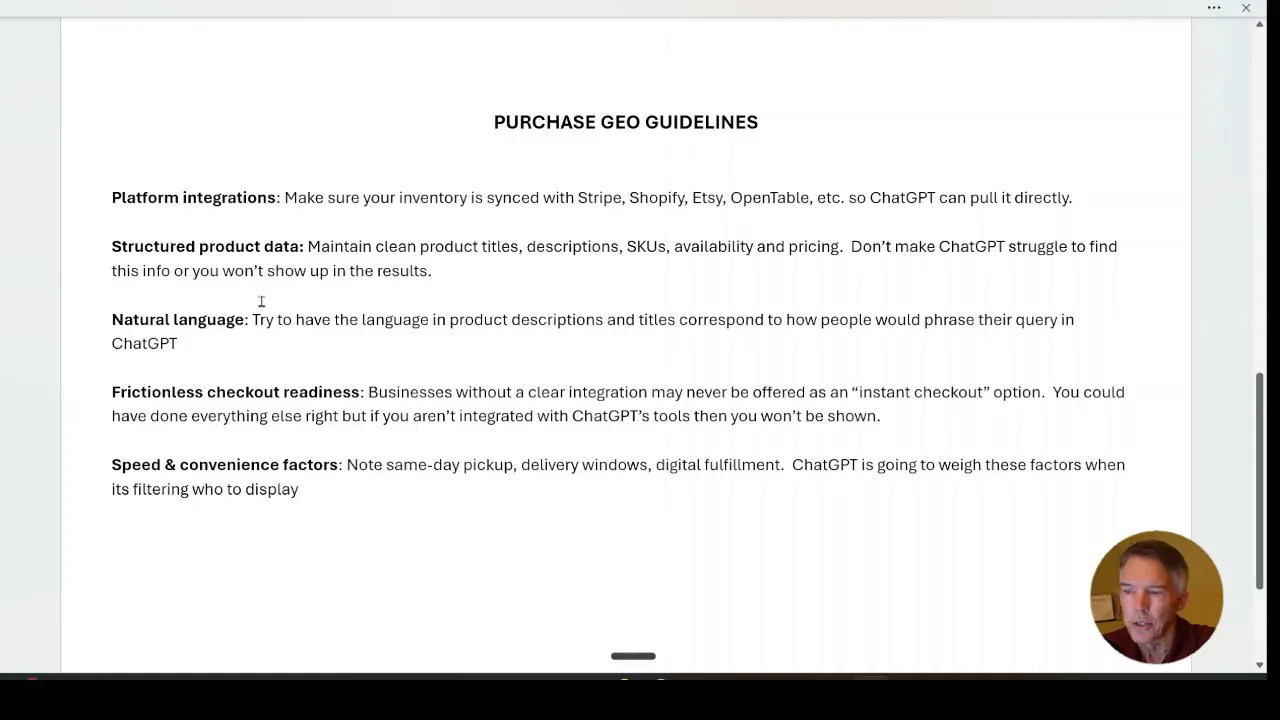
Three-Stage Action Plan to Win at GEO
Work in stages. A three-month ramp is realistic to get meaningful improvements.
Stage 1 — Lay the Foundation (Weeks 1–4)
- Clean up all online listings for consistent Name/Address/Phone (NAP).
- Ask satisfied customers for recent Google and Yelp reviews.
- Update About and FAQ pages into short question-and-answer formats.
- Add schema markup for locations, hours, products and FAQs.
- Secure at least one local press mention or community listing (sponsor an event, issue a press release).
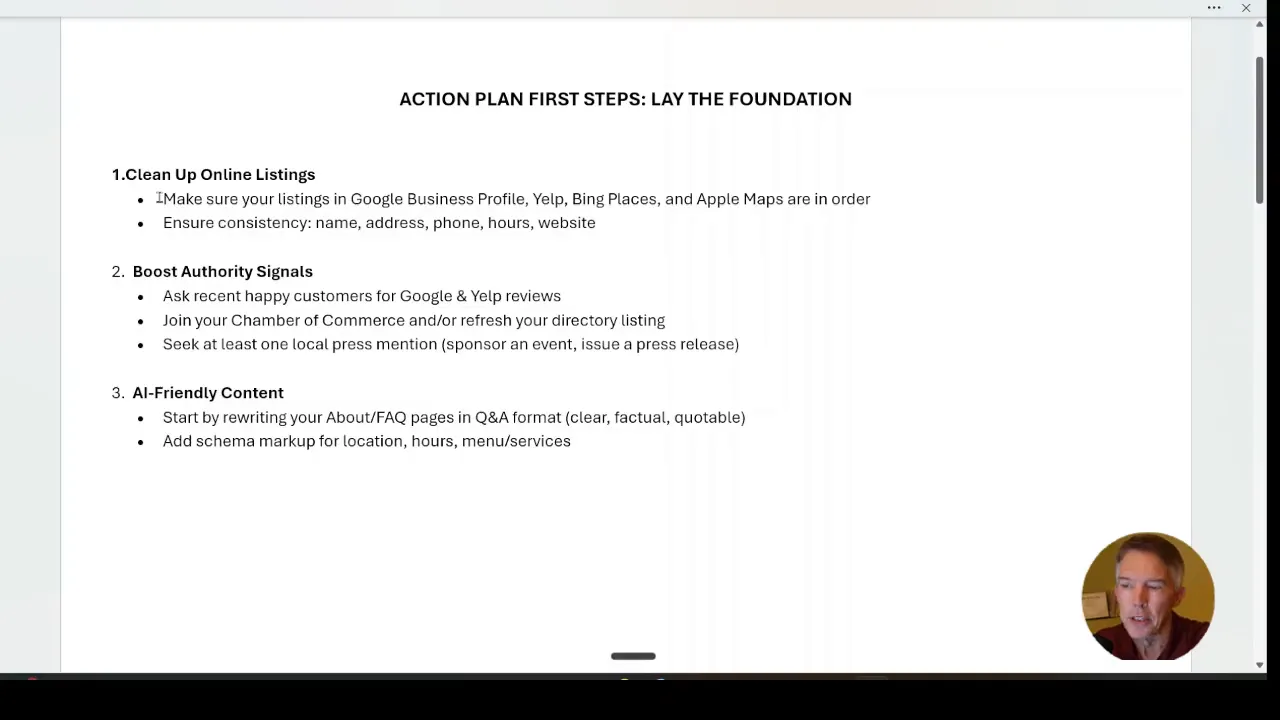
Stage 2 — Improve Discoverability (Weeks 4–8)
- Create short, factual blog posts or FAQs answering common customer queries (use the exact phrase customers use).
- Build social proof: highlight partnerships, named testimonials, and memberships (chamber of commerce).
- Share content on LinkedIn, Facebook and forums where AI models can find social proof and authentic conversations.
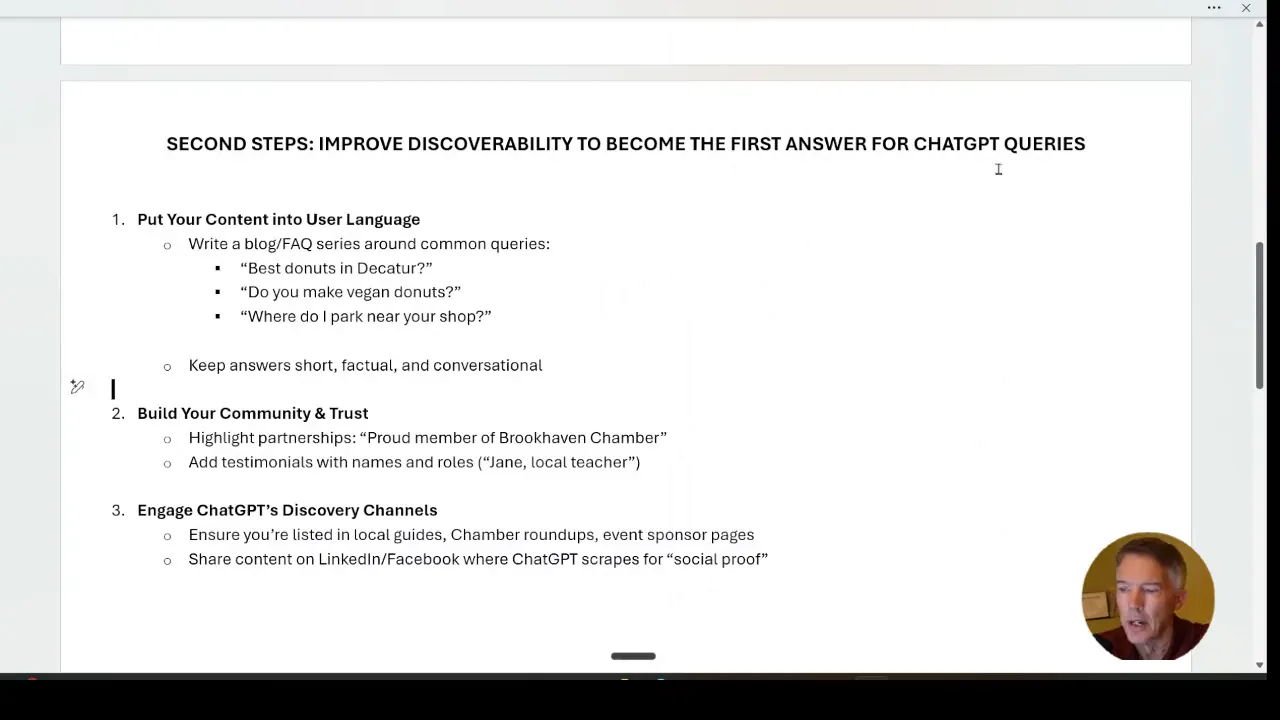
Stage 3 — Product & Transaction Optimization (Weeks 8–12)
- Integrate point-of-sale and inventory systems with platforms that support AI checkout (Shopify, Stripe, Etsy, etc.).
- Standardize product titles and descriptions: include attributes such as size, color, pickup options.
- Ensure real-time inventory is synced and publish clear refund/cancellation/pickup policies.
- Test using ChatGPT queries and iterate on missing pieces.
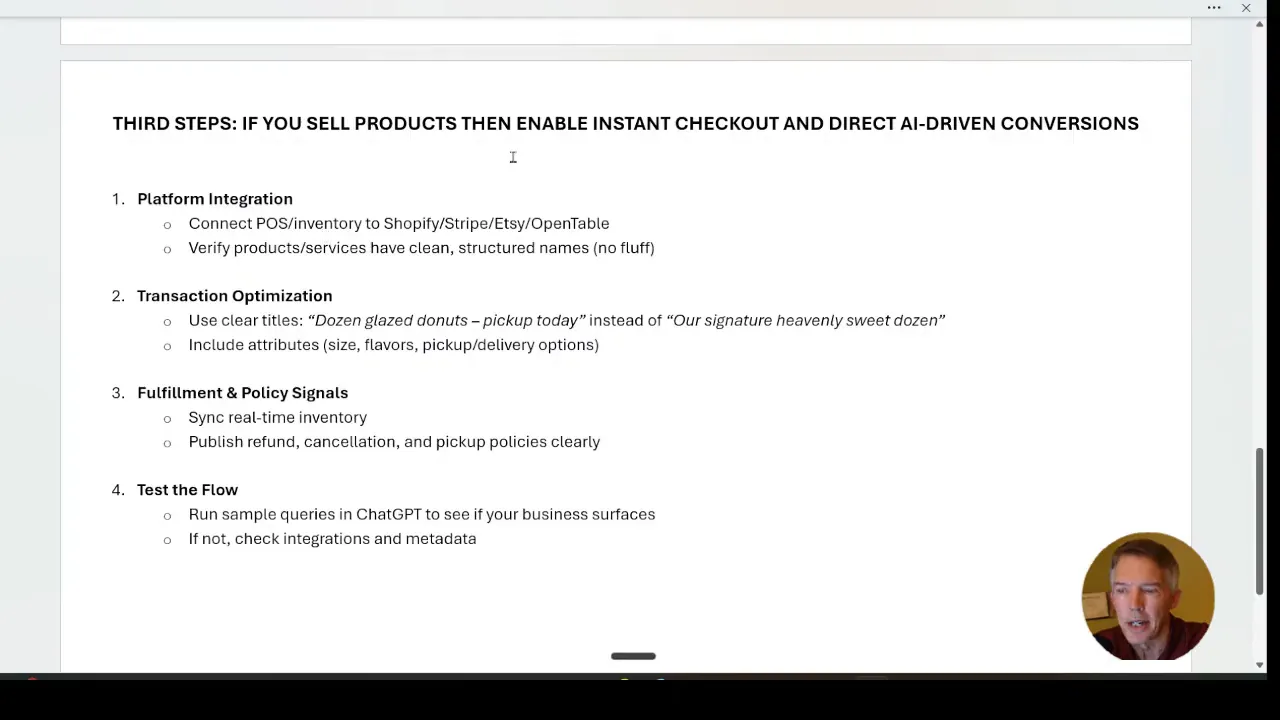
Testing: Use ChatGPT as Your QA Tool
Ask ChatGPT to recommend stores in your category. If it omits you, ask why — what did it look for, and what parts of your site did it inspect? Provide your store URL and request a site analysis (what it thinks you sell and who you should target). Follow up with specific questions and use the model’s answers to prioritize fixes.
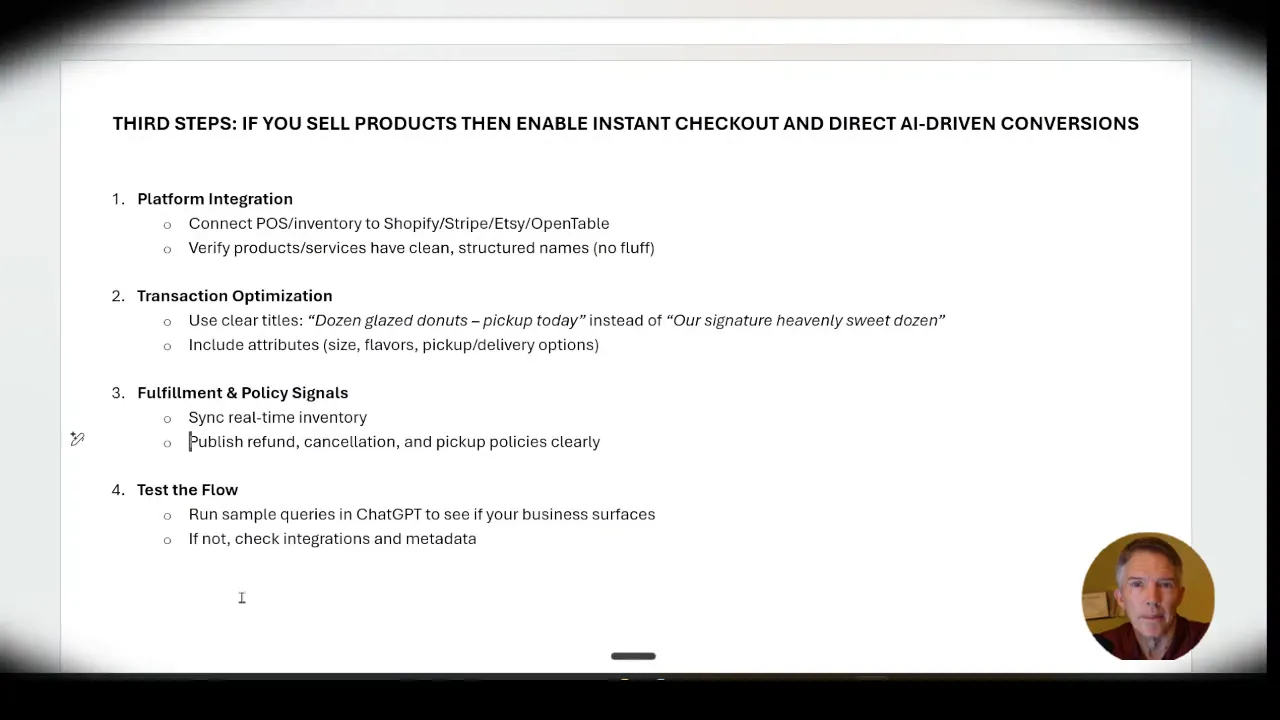
Authority Signals: Practical Tactics
- Consider PR outreach to get featured in “Best of” lists or trusted review sites. In some cases paid placement on reputable review platforms may be an option, but weigh trust and authenticity.
- Target niche/local long-tail queries with high-quality blog posts — optimize for “product + city” where relevant.
- Cultivate authentic Q&A and forum presence (Reddit, Quora). AI models value natural user conversations.
- Enrich About pages with credentials, team bios and links to professional profiles to boost credibility.
- Create structured comparison pages (tables) comparing products, features and pricing — these formats align well with high-intent queries.
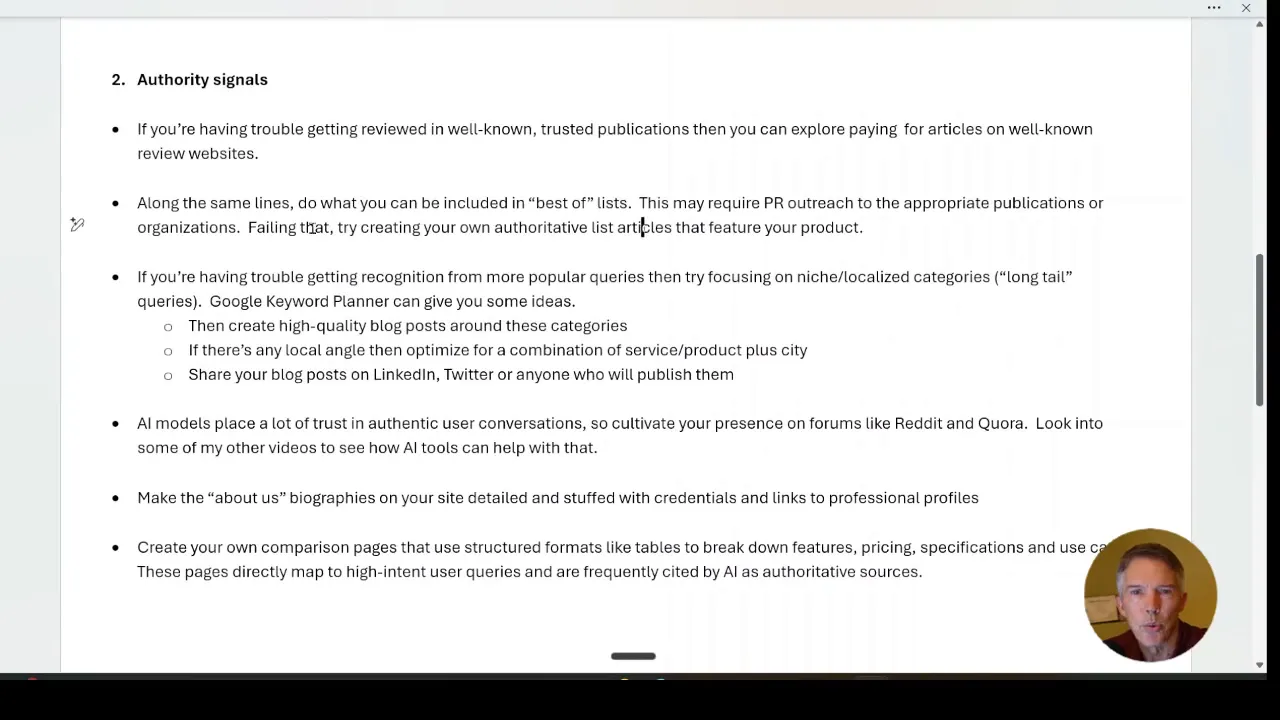
Site AI Usability: Schema, HTML Rendering, and Feed Hygiene
Make it easy for crawlers and models to read your data:
- Schema markup: Add JSON-LD product schema (price, availability, ratings) and FAQ schema for Q&A content. Schema.org documents available types.
- HTML rendering: Many crawlers and language models have limited ability to execute JavaScript. If product info is rendered only via JS, models may miss it. Ensure critical product info is present in HTML.
- Product feed cleanliness: Structured attributes (size, color, SKU) must be complete and consistent. Unstructured text — product descriptions and reviews — should also stay consistent across channels.
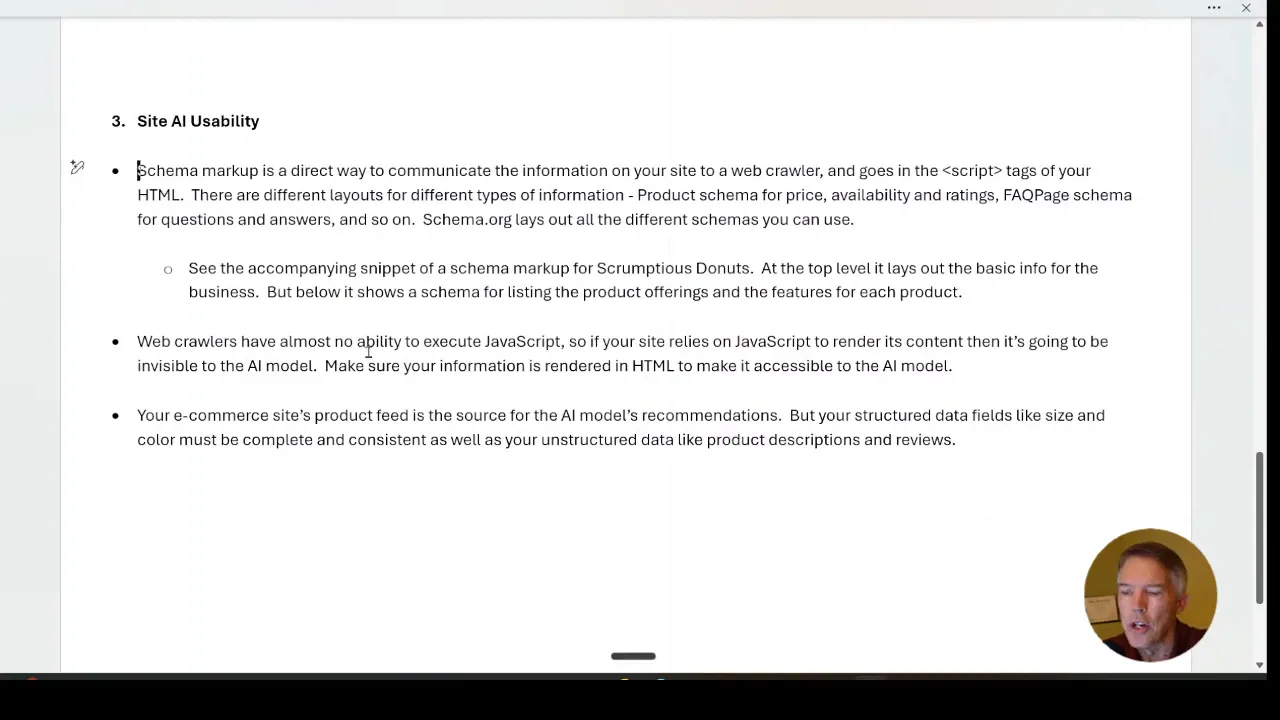
Concrete Action Plan for a Cosmetic Brand Selling Beauty Products
This is a real-life example that aims to give you practical tips to start. So, if you sell cosmetics for women, start here — focused, practical steps you can execute in 4–8 weeks:
- Clean listings: Verify your Google Business Profile, Bing Places and Etsy/Shopify storefronts have consistent brand name, address (if applicable), phone and email.
- Product data audit: Standardize product titles to include key attributes customers ask for (example: “Hydrating Hyaluronic Serum — 30ml — For Dry Skin — Vegan”). Keep titles under 70 characters and avoid marketing slogans.
- Schema & FAQs: Add product schema for price, size, stock and ratings. Add FAQ schema for common questions like “Is this product cruelty-free?” and “How long until I see results?”.
- Checkout integration: Ensure your Shopify or ecommerce platform is connected to Stripe and that inventory is synced in real time. Set up clear shipping windows and same-day pickup options if possible.
- Trust signals: Collect recent verified reviews and display them with reviewer names and skin-type context (e.g., “Maya, 34, oily skin”). Add certifications (cruelty-free, vegan) as badges and list ingredient transparency pages.
- Conversational content: Publish short Q&A blog posts matching user intent: “Best serum for dry mature skin,” “How to layer serum and moisturizer.” Keep answers concise and factual for easy AI quoting.
- Test with ChatGPT: Ask “Recommend anti-aging serums for sensitive skin” and see if your product appears. If not, ask ChatGPT what it looked for and iterate.
Frequently Asked Questions (FAQ)
Q: How is GEO different from SEO?
A: SEO optimizes for ranking in search engine results pages. GEO optimizes to be the answer a generative model returns. That requires concise, quotable content, trusted citations, and (for products) checkout integrations.
Q: Do I need to change all my marketing copy?
A: Not all of it. Prioritize About, FAQ and product pages — convert them to concise Q&A or structured formats and add schema. Preserve branded storytelling elsewhere, but keep the facts clear where models will pull them.
Q: Is schema markup mandatory?
A: Mandatory is strong — but strongly recommended. Schema gives crawlers and models explicit fields to read (price, availability, hours). It materially increases the chance models will find and use your data.
Q: How long until I see results?
A: You’ll likely see improvements in weeks for discovery (listings, reviews) and 6–12 weeks for product discovery if you complete integrations and tidy product data. A realistic initial window is three months.
Q: What if my site uses heavy JavaScript?
A: Make sure product-critical content is server-rendered or available in the page HTML. If your product grids or details require user-side JS, crawlers and models may not see them.
Summary & Next Steps
GEO is an urgent evolution of digital visibility. To compete you must: (1) make your facts easy to read (concise copy + schema), (2) build authentic authority (recent reviews, local citations), and (3) integrate your commerce stack so chat-driven purchases can complete without friction. Start with a three-stage plan — foundation, discoverability, and transaction optimization — and use ChatGPT itself to test and iterate.
----
This article was created from the video ChatGPT Instant Checkout – Intro to GEO and How It Differs From SEO. Go check it out!


